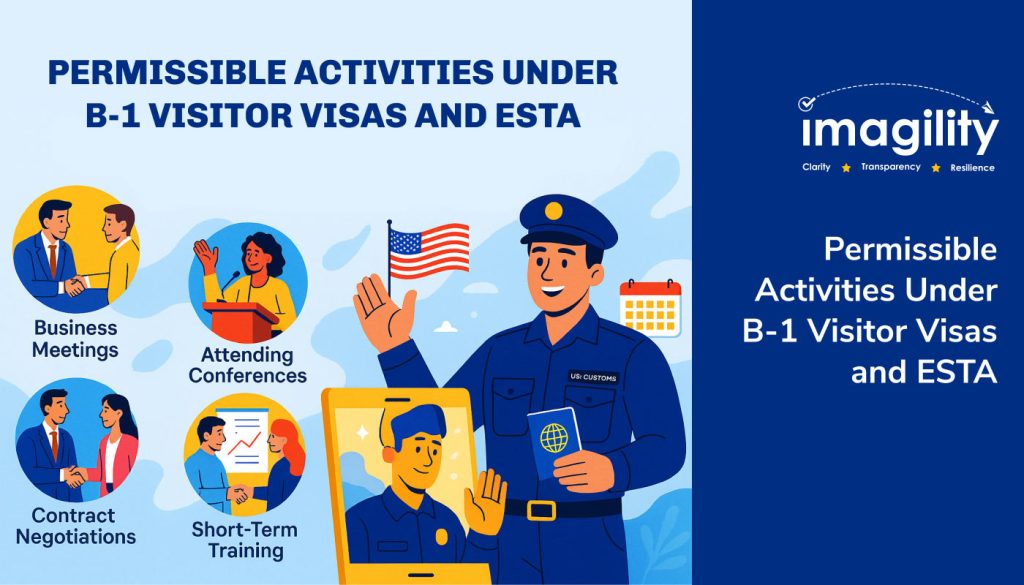What You Can (and Can’t) Do in the U.S.
When planning a short-term trip to the United States for business purposes, travelers often rely on either the B-1 Business Visitor Visa or the ESTA (Electronic System for Travel Authorization) under the Visa Waiver Program (VWP). While both options allow entry into the U.S. without pursuing long-term employment or immigration, it’s important to understand the limits of what you can legally do during your stay in the U.S.
Crossing the line, even unintentionally, can lead to visa denials, deportation, or bans from re-entry. This blog helps break down permissible activities under the B-1 visa and ESTA, so you can stay compliant and focused on your goals.
Understanding the Basics: B-1 vs. ESTA
- B-1 Business Visitor Visa: For travelers from non-VWP countries or those needing longer stays. Typically allows up to 6 months in the U.S., with a possible extension.
- ESTA (Visa Waiver Program): For citizens of participating countries, it allows business or tourism visits for up to 90 days without a visa. Must be approved before boarding a U.S.-bound flight.
Remember, both, B-1 visitor visa and ESTA, do not allow actual employment or receiving income from a U.S. source.
What You Can Do on a B-1 Visa or ESTA (Business-Related)
Here are activities that are generally permitted under both the B-1 and ESTA for business purposes
- Attend Business Meetings
Participate in meetings with partners, clients, or stakeholders. Discuss contracts, partnerships, or potential investments. - Attend Conferences or Seminars
Join professional events, conventions, or trade shows related to your industry. Learning and networking is okay; working the event as a vendor is not. - Negotiate Contracts
You can enter the U.S. to negotiate business deals, sign contracts, or review commercial agreements. - Consult with U.S. Business Associates
Consulting with your company’s U.S. branch or partners on strategy, plans, or projects is fine, provided you’re not being compensated in the U.S. - Undertake Independent Research
Conduct research that benefits your foreign employer or business. It shouldn’t be hands-on or generate income in the U.S. - Participate in Litigation
If your presence is needed for court proceedings (e.g., testifying in a lawsuit, attending depositions), you can do so under B-1 or ESTA. - Purchase Goods or Materials
Coming to the U.S. to buy equipment, tools, or supplies is allowed, as long as you’re not directly managing the shipment or inventory process.
What You Cannot Do on a B-1 Visa or ESTA
Here are some activities that are not permitted under either status.
- Work for a U.S. Company
You cannot be employed, paid by, or directly contribute labor to a U.S. business while in the country, even part-time or unpaid. - Enroll in a Course of Study
You can attend short informational seminars, but full-time or part-time study isn’t allowed. That requires an F-1 or M-1 student visa. - Engage in Paid Performances
Entertainers, artists, or athletes cannot perform for pay under a B-1 or ESTA. This includes paid speaking gigs, concerts, or sporting events. - Operate a Business or Manage U.S. Employees
While you can explore business opportunities, you cannot actively run or manage a business in the U.S. under these visas. - Internships or Hands-On Training
Even unpaid internships or volunteer work that benefits a U.S. company is typically not allowed.
Common Scenarios and Clarifications
- Coming for Training?
If your company is U.S.-based and you’re receiving training, this may be allowed under B-1 if it’s short-term and you’re not working. - Remote Work While Visiting the U.S.?
Technically, if you’re working remotely for a foreign employer and not providing services to U.S. entities, this is a gray area. It’s best to consult an immigration attorney. - Visiting Multiple U.S. Cities?
That’s okay under both B-1 and ESTA, as long as your purpose remains consistent with your visa.
Final Tips for Staying Compliant
- Be Honest at the Border
Clearly explain the purpose of your visit to Customs and Border Protection (CBP). Misrepresenting your intentions can lead to denial of entry. - Carry Supporting Documents
Bring copies of invitations to meetings, conference schedules, or hotel bookings to validate your business agenda. - Avoid Overstaying
The 90-day ESTA limit and the 6-month B-1 limit are strict. Overstaying can lead to future visa denials or travel bans. - If You Need to Work, Apply for the Right Visa
If your activities go beyond what’s permitted, it’s worth exploring an H-1B visa, O-1 visa, L-1 visa, or other appropriate work visas.
Conclusion
Visiting the U.S. for business under a B-1 visa or ESTA can open doors, but only if you stay within the boundaries of what’s allowed. Understanding the dos and don’ts ensures a smooth experience and protects your future immigration prospects.
If you’re unsure whether your planned activities are allowed, consult with a qualified immigration attorney or a compliance platform like Imagility to help guide your travel and business decisions.










